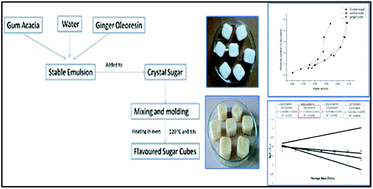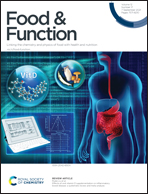Encapsulation of ginger oleoresin in co-crystallized sucrose: development, characterization and storage stability†
Abstract
Ginger oleoresin was emulsified with gum acacia and encapsulated in a sucrose matrix by co-crystallization. The increased void space and surface area of sucrose provided a porous base for the incorporation of oleoresin. This co-crystallization led to modification from crystalline to irregular agglomerates, as evident from X-ray diffraction and differential scanning calorimetry. Hygroscopicity, water sorption isotherms and water activity demonstrated changes due to the change in crystallinity of sucrose. The active components such as [6]-, [8]- and [10]-gingerols and [6]-shogaol were quantified by HPLC. The encapsulation efficiency of [6]-gingerol was 45.59%. The storage kinetics at different relative humidity levels and temperatures indicated [6]-gingerol to be the most stable among the gingerols studied. A temperature of 25 °C and relative humidity of 33% proved to be the best storage conditions for the ginger flavoured sugar cubes. Thus, co-crystallization for the encapsulation of ginger oleoresin serves a dual purpose, i.e., protection and a mode of delivering a spicy flavour.



 Please wait while we load your content...
Please wait while we load your content...